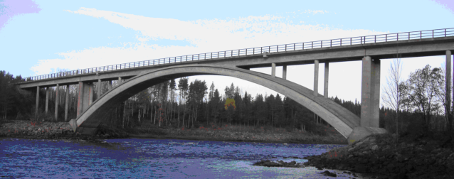The concrete arch bridge over Kalix River at Långforsen was built in 1960 and has a mid-span of 89,5 m and a height of 13,7 m. The bridge owner, Trafikverket, wanted to increase its allowable axle load from 225 to 300 kN. Monitoring and calculations were carried out at Luleå University of Technology, Sabourova et al (2019) and Wang et al (2019).
Object description
(No object description available.)
Civil engineering type
:
Year of construction
:
1960
Composed of materials
:
Location coordinates
:
65° 54' 23.18" N, 22° 55' 29.29" E
Country
:
Loading map...
{"minzoom":false,"maxzoom":false,"mappingservice":"leaflet","width":"auto","height":"350px","centre":false,"title":"","label":"","icon":"","lines":[],"polygons":[],"circles":[],"rectangles":[],"copycoords":false,"static":false,"zoom":false,"defzoom":6,"layers":["OpenStreetMap"],"image layers":[],"overlays":[],"resizable":false,"fullscreen":false,"scrollwheelzoom":true,"cluster":false,"clustermaxzoom":20,"clusterzoomonclick":true,"clustermaxradius":80,"clusterspiderfy":true,"geojson":"","clicktarget":"","imageLayers":[],"locations":[{"text":"\u003Cdiv class=\"mw-parser-output\"\u003E\u003Cp\u003EKalix river bridge\n\u003C/p\u003E\u003C/div\u003E","title":"Kalix river bridge\n","link":"","lat":65.90643888888889,"lon":22.924802777777778,"icon":"/images/imsafe/c/c8/Blue-marker.png"}],"imageoverlays":null}
Object analysis
Field tests were carried out under service condition and with ambient vibrations. The test results were used to update and validate Finite Element Models. At last, the refined models were used to check the possibility to increase the axle load.
Object state
The critical sections are in the beams carrying the rail on top of the arch in the section where the beams are united with the arch. Here the stresses in the longitudinal bottom reinforcement were slightly too high. These sections have been studied in a FEM model for different loads and results show maximum strains of about 50·10-6 corresponding to stresses of only about 10 MPa in the reinforcement in the critical sections. Live load vertical deflections of the crown of the arch are of the order of only ± 6 mm. Dynamic studies have also been made showing that fatigue is no issue. Altogether the studies show that the bridge can carry an increased axle load of 300 kN without problems.
Observed deterioration processes
:
Observed damage types
:
Performance indicators
:
Deformation, Dynamic response (acceleration/damping/frequencies)
Images
Documents
This case study was contributed by Frida Liljefors of Norwegian University Of Science And Technology. Last edited by technical staff.
